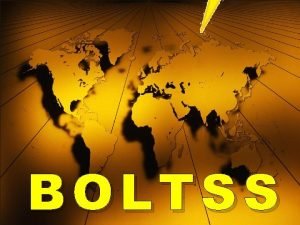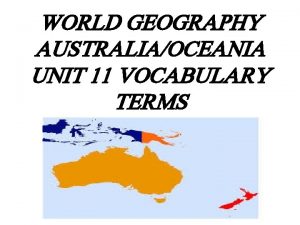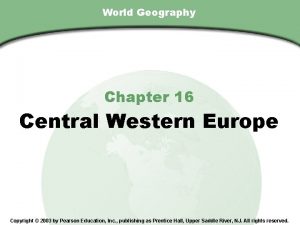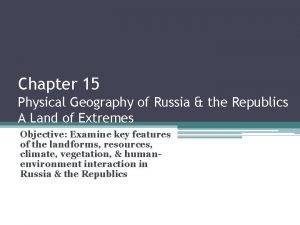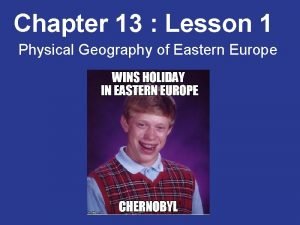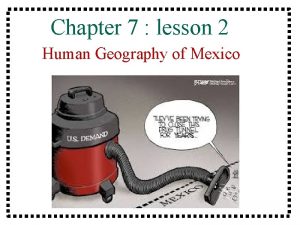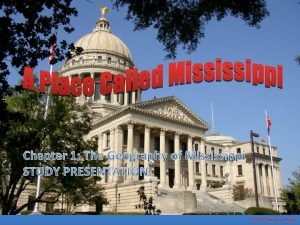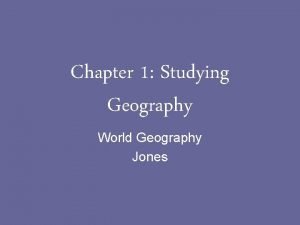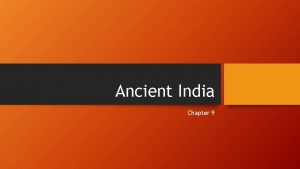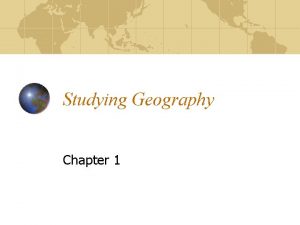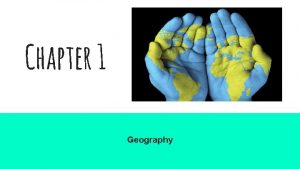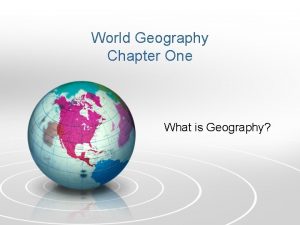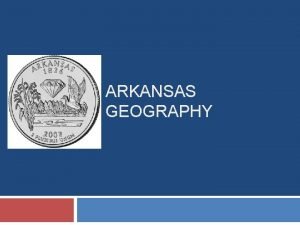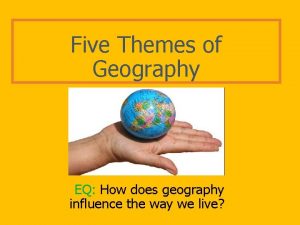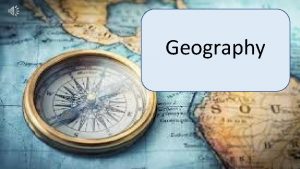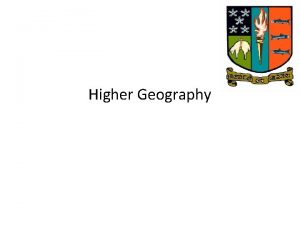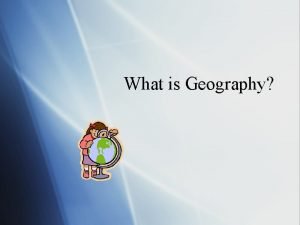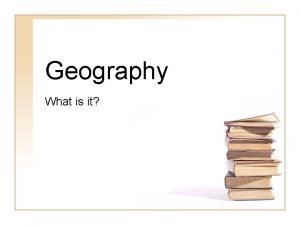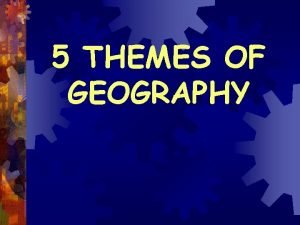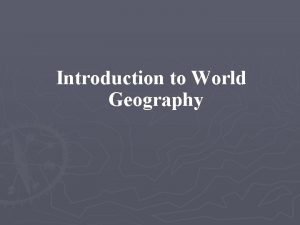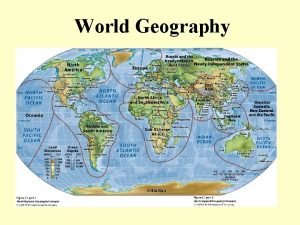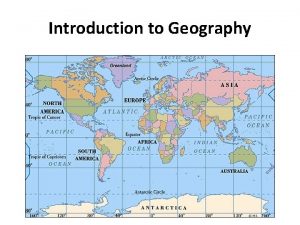Chapter 1 What is Geography How Does Geography



















- Slides: 19

Chapter 1 What is Geography? How Does Geography Affect You?

Lesson 1 Thinking Like a Geographer • Geography is the study of Earth in all its variety • We study the plants and animals, climate, environment, people, and their impact on the Earth.

A Geographer’s View of Place Geographers look at places around the world and try to find similar places and then make predictions about what is going to happen in the future • Landforms, individual features of the land are important to geographers • Then they look at the people living in the place and how they interact with their environment, natural surroundings. •


Global Positioning System (GPS) GPS allows geographers to label exact locations on a map. • First you put a receiver in a certain place, and then the GPS satellite picks up the signal and can find the exact location. • GPS is also used in vehicles to help someone get where they are going. •

Geographic Information Systems(GIS) This is a type of computer software. • They input tons of data in the computer like how many times a volcano erupts, and when, then they use the computer to tell them when the volcano will erupt next. •


Clues to Our Past Geographers, historians, and archaeologists look for artifacts (tools, pottery, paintings, weapons, and other items made a long time ago) to help learn about the past. • They also study fossils, the remains of humans and animals to see what they ate and how they hunted. •

Lesson 2 The Earth in Space Earth and the other planets orbits around the sun. • The Earth takes 365 and ¼ days to travel around the sun, while Pluto takes 250 years. • Jupiter, Neptune, Saturn, and Uranus are the largest planets. • https: //www. youtube. com/wa tch? v=1 Eh 5 Bp. Sn. BBw •

Sun, Earth, & Moon • • Earth is 93 million miles from the sun. The sun is 27 million degrees The layer of air surrounding the Earth, atmosphere, supports life. Nitrogen and Oxygen make up 99% of the Earth’s atmosphere. The Earth rotates on its axis, imaginary line running through the world. The Earth makes one revolution, orbit around the sun, every year. We have a leap year every 4 years to make up for the ¼ of a day every year.

The Sun and The Seasons Earth is tilted 23 ½ degrees. • On June 21 we have a summer solstice where we have the most hours of light. What is it like in Australia? • On December 22 we have a winter solstice where we have the fewest hours of light • March 21 and September 23 we have equinox. This is when the days and nights are the same length. •


Lesson 3 Forces Shaping the Earth • • • Earth is made up of 3 layers; crust, mantle, & core Core=hot iron mixed with other metals & rock Mantle=a layer of liquid rock 1800 miles thick Crust=uppermost part of Earth. Only 31 -62 miles Magma comes from the mantle during eruptions Continents are the massive land areas on the crust

Forces Beneath Earth’s Crust Plate tectonics is a theory to explain earth’s structure • Huge slabs of rock that float on top of liquid rock • Scientists believe that the land was all one mass called a Pangaea • Scientists also believe they split apart over millions of years moving apart 1. 8 inches a year. •

When Plates Meet If plates collide they can create mountains, and earthquakes can occur (which may cause tsunamis, huge tidal waves) • If they move in opposite directions they can create faults, or cracks in the Earth’s crust • Serious earthquakes occur at the fault like the one in California, San Andreas Fault. •

Forces Shaping Landforms • • • Weathering, process of breaking surface rock into boulders, gravel, and soil Water, frost, chemicals, & plants cause weathering Erosion is the process of wearing away or moving weathered material Rivers and wind carry sand soil and acts like sandpaper Glaciers are slow-moving mountains of ice which cut smooth deep valleys

Lesson 4 Landforms and Waterways On land the tallest mountain is Mt. Everest, which lies in the Asian Himalayas at 29, 035 feet • The difference between plains and plateaus are their elevation, height above sea level • Plains are low-lying stretches of land • Plateaus are flat plots of land at a higher elevation •

Landforms and Waterways • • • An isthmus is a narrow piece of land that connects two larger pieces of land A peninsula is a piece of land surrounded 3 sides by water An island is a piece of land completely surrounded by water Continental shelves are plateaus several miles underwater Valleys on the ocean floor are called trenches, lowest spots in the Earth’s crust

Bodies of Water • • • 70% of Earth’s surface is covered by water Very small percentage of fresh water A strait is a narrow body of water between two large pieces of land A wider passage is called a channel Delta is an area formed from a soil deposit located at the mouth of a
 Ap human geography frq examples
Ap human geography frq examples 5 themes of geography ap human geography
5 themes of geography ap human geography Proruption ap human geography
Proruption ap human geography Boltss
Boltss Alesha dixon he does nothing
Alesha dixon he does nothing Ap human geography chapter 11 vocab
Ap human geography chapter 11 vocab Chapter 16 ap human geography
Chapter 16 ap human geography The cultural geography of europe chapter 12 answer key
The cultural geography of europe chapter 12 answer key Chapter 27 section 1 landforms and resources
Chapter 27 section 1 landforms and resources Chapter 22 human geography of southwest asia
Chapter 22 human geography of southwest asia Chapter 16 world geography
Chapter 16 world geography Russia and the eurasian republics physical map
Russia and the eurasian republics physical map Chapter 15 lesson 1 physical geography of north africa
Chapter 15 lesson 1 physical geography of north africa Chapter 13 lesson 1 physical geography of eastern europe
Chapter 13 lesson 1 physical geography of eastern europe Chapter 11 ap human geography
Chapter 11 ap human geography Chapter 15 cultural geography of russia answer key
Chapter 15 cultural geography of russia answer key Lesson 2 human geography of canada
Lesson 2 human geography of canada Lingua franca definition ap human geography
Lingua franca definition ap human geography Chapter 13 human geography of europe
Chapter 13 human geography of europe Tennessee tombigbee
Tennessee tombigbee



